Management Theory: Analysis of McGregor's Theory X and Theory Y
VerifiedAdded on 2021/04/21
|9
|2899
|180
Essay
AI Summary
This essay delves into the realm of management theory, focusing on the analysis of the statement "Workers are inherently lazy and require constant supervision to ensure they achieve set tasks." The essay centers on McGregor's Theory X and Theory Y, exploring how these theories influence employee motivation and leadership approaches. It examines the assumptions underlying each theory, their practical applications, and their respective strengths and weaknesses. Furthermore, the essay suggests specific implementations of these theories within organizational contexts, while also evaluating suitable alternatives, such as McClelland's Three Needs Theory, to address potential limitations. The discussion covers the historical context, modern relevance, and the impact of these theories on employee behavior and organizational outcomes, providing a comprehensive overview of the subject matter. This analysis highlights the evolution of management thought and its impact on contemporary business practices, offering valuable insights into effective leadership and employee engagement strategies.
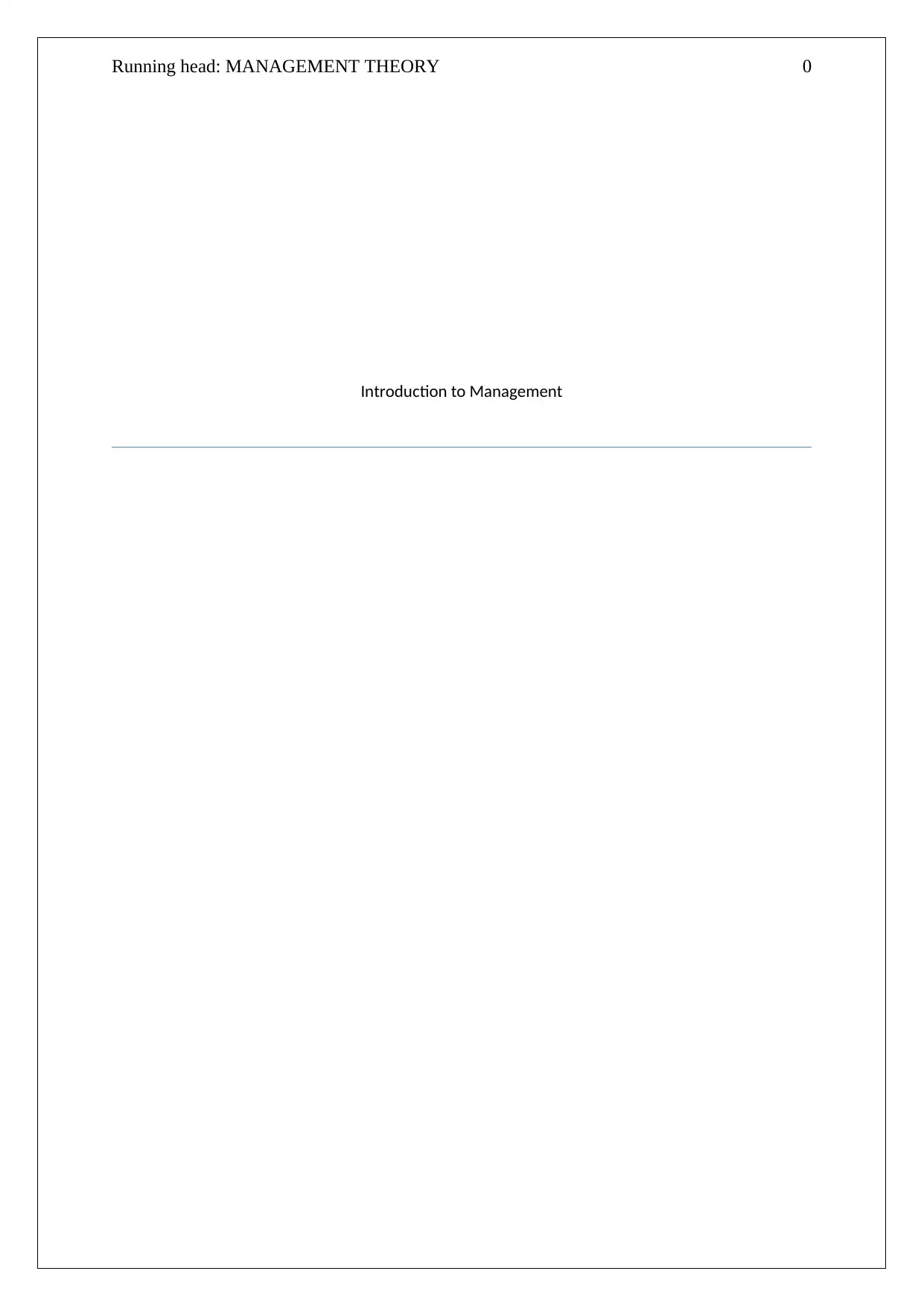
Running head: MANAGEMENT THEORY 0
Introduction to Management
Introduction to Management
Paraphrase This Document
Need a fresh take? Get an instant paraphrase of this document with our AI Paraphraser
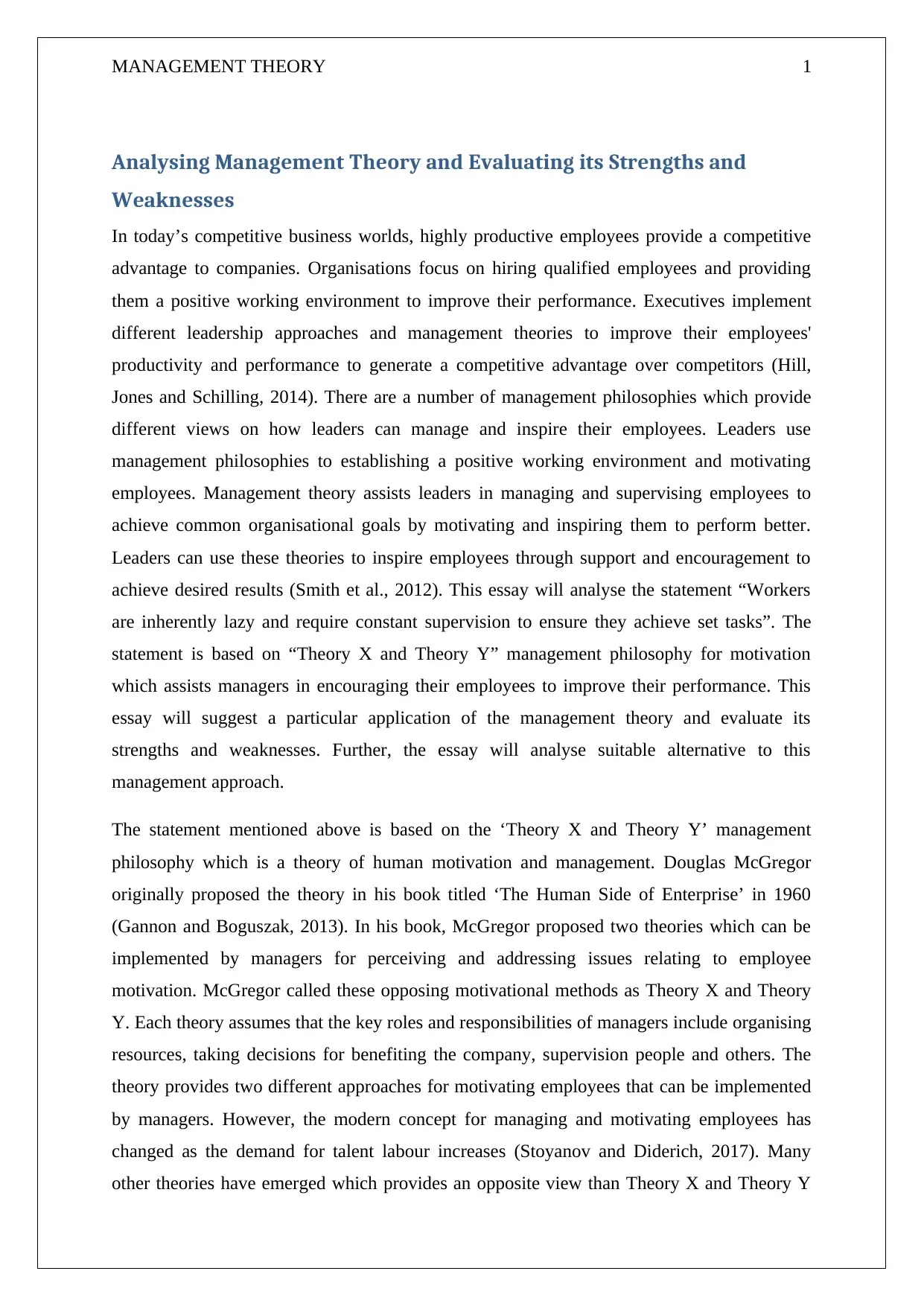
MANAGEMENT THEORY 1
Analysing Management Theory and Evaluating its Strengths and
Weaknesses
In today’s competitive business worlds, highly productive employees provide a competitive
advantage to companies. Organisations focus on hiring qualified employees and providing
them a positive working environment to improve their performance. Executives implement
different leadership approaches and management theories to improve their employees'
productivity and performance to generate a competitive advantage over competitors (Hill,
Jones and Schilling, 2014). There are a number of management philosophies which provide
different views on how leaders can manage and inspire their employees. Leaders use
management philosophies to establishing a positive working environment and motivating
employees. Management theory assists leaders in managing and supervising employees to
achieve common organisational goals by motivating and inspiring them to perform better.
Leaders can use these theories to inspire employees through support and encouragement to
achieve desired results (Smith et al., 2012). This essay will analyse the statement “Workers
are inherently lazy and require constant supervision to ensure they achieve set tasks”. The
statement is based on “Theory X and Theory Y” management philosophy for motivation
which assists managers in encouraging their employees to improve their performance. This
essay will suggest a particular application of the management theory and evaluate its
strengths and weaknesses. Further, the essay will analyse suitable alternative to this
management approach.
The statement mentioned above is based on the ‘Theory X and Theory Y’ management
philosophy which is a theory of human motivation and management. Douglas McGregor
originally proposed the theory in his book titled ‘The Human Side of Enterprise’ in 1960
(Gannon and Boguszak, 2013). In his book, McGregor proposed two theories which can be
implemented by managers for perceiving and addressing issues relating to employee
motivation. McGregor called these opposing motivational methods as Theory X and Theory
Y. Each theory assumes that the key roles and responsibilities of managers include organising
resources, taking decisions for benefiting the company, supervision people and others. The
theory provides two different approaches for motivating employees that can be implemented
by managers. However, the modern concept for managing and motivating employees has
changed as the demand for talent labour increases (Stoyanov and Diderich, 2017). Many
other theories have emerged which provides an opposite view than Theory X and Theory Y
Analysing Management Theory and Evaluating its Strengths and
Weaknesses
In today’s competitive business worlds, highly productive employees provide a competitive
advantage to companies. Organisations focus on hiring qualified employees and providing
them a positive working environment to improve their performance. Executives implement
different leadership approaches and management theories to improve their employees'
productivity and performance to generate a competitive advantage over competitors (Hill,
Jones and Schilling, 2014). There are a number of management philosophies which provide
different views on how leaders can manage and inspire their employees. Leaders use
management philosophies to establishing a positive working environment and motivating
employees. Management theory assists leaders in managing and supervising employees to
achieve common organisational goals by motivating and inspiring them to perform better.
Leaders can use these theories to inspire employees through support and encouragement to
achieve desired results (Smith et al., 2012). This essay will analyse the statement “Workers
are inherently lazy and require constant supervision to ensure they achieve set tasks”. The
statement is based on “Theory X and Theory Y” management philosophy for motivation
which assists managers in encouraging their employees to improve their performance. This
essay will suggest a particular application of the management theory and evaluate its
strengths and weaknesses. Further, the essay will analyse suitable alternative to this
management approach.
The statement mentioned above is based on the ‘Theory X and Theory Y’ management
philosophy which is a theory of human motivation and management. Douglas McGregor
originally proposed the theory in his book titled ‘The Human Side of Enterprise’ in 1960
(Gannon and Boguszak, 2013). In his book, McGregor proposed two theories which can be
implemented by managers for perceiving and addressing issues relating to employee
motivation. McGregor called these opposing motivational methods as Theory X and Theory
Y. Each theory assumes that the key roles and responsibilities of managers include organising
resources, taking decisions for benefiting the company, supervision people and others. The
theory provides two different approaches for motivating employees that can be implemented
by managers. However, the modern concept for managing and motivating employees has
changed as the demand for talent labour increases (Stoyanov and Diderich, 2017). Many
other theories have emerged which provides an opposite view than Theory X and Theory Y
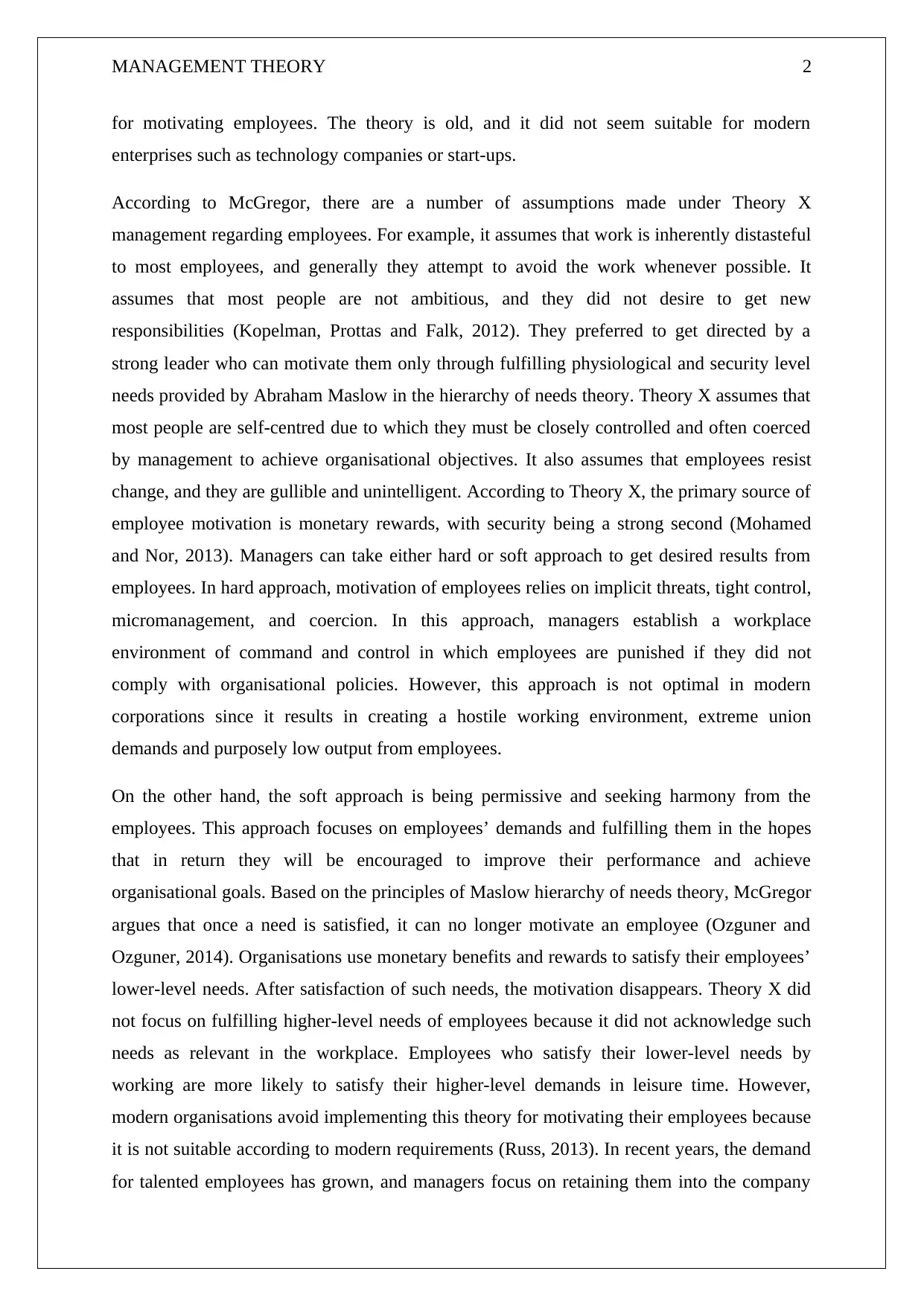
MANAGEMENT THEORY 2
for motivating employees. The theory is old, and it did not seem suitable for modern
enterprises such as technology companies or start-ups.
According to McGregor, there are a number of assumptions made under Theory X
management regarding employees. For example, it assumes that work is inherently distasteful
to most employees, and generally they attempt to avoid the work whenever possible. It
assumes that most people are not ambitious, and they did not desire to get new
responsibilities (Kopelman, Prottas and Falk, 2012). They preferred to get directed by a
strong leader who can motivate them only through fulfilling physiological and security level
needs provided by Abraham Maslow in the hierarchy of needs theory. Theory X assumes that
most people are self-centred due to which they must be closely controlled and often coerced
by management to achieve organisational objectives. It also assumes that employees resist
change, and they are gullible and unintelligent. According to Theory X, the primary source of
employee motivation is monetary rewards, with security being a strong second (Mohamed
and Nor, 2013). Managers can take either hard or soft approach to get desired results from
employees. In hard approach, motivation of employees relies on implicit threats, tight control,
micromanagement, and coercion. In this approach, managers establish a workplace
environment of command and control in which employees are punished if they did not
comply with organisational policies. However, this approach is not optimal in modern
corporations since it results in creating a hostile working environment, extreme union
demands and purposely low output from employees.
On the other hand, the soft approach is being permissive and seeking harmony from the
employees. This approach focuses on employees’ demands and fulfilling them in the hopes
that in return they will be encouraged to improve their performance and achieve
organisational goals. Based on the principles of Maslow hierarchy of needs theory, McGregor
argues that once a need is satisfied, it can no longer motivate an employee (Ozguner and
Ozguner, 2014). Organisations use monetary benefits and rewards to satisfy their employees’
lower-level needs. After satisfaction of such needs, the motivation disappears. Theory X did
not focus on fulfilling higher-level needs of employees because it did not acknowledge such
needs as relevant in the workplace. Employees who satisfy their lower-level needs by
working are more likely to satisfy their higher-level demands in leisure time. However,
modern organisations avoid implementing this theory for motivating their employees because
it is not suitable according to modern requirements (Russ, 2013). In recent years, the demand
for talented employees has grown, and managers focus on retaining them into the company
for motivating employees. The theory is old, and it did not seem suitable for modern
enterprises such as technology companies or start-ups.
According to McGregor, there are a number of assumptions made under Theory X
management regarding employees. For example, it assumes that work is inherently distasteful
to most employees, and generally they attempt to avoid the work whenever possible. It
assumes that most people are not ambitious, and they did not desire to get new
responsibilities (Kopelman, Prottas and Falk, 2012). They preferred to get directed by a
strong leader who can motivate them only through fulfilling physiological and security level
needs provided by Abraham Maslow in the hierarchy of needs theory. Theory X assumes that
most people are self-centred due to which they must be closely controlled and often coerced
by management to achieve organisational objectives. It also assumes that employees resist
change, and they are gullible and unintelligent. According to Theory X, the primary source of
employee motivation is monetary rewards, with security being a strong second (Mohamed
and Nor, 2013). Managers can take either hard or soft approach to get desired results from
employees. In hard approach, motivation of employees relies on implicit threats, tight control,
micromanagement, and coercion. In this approach, managers establish a workplace
environment of command and control in which employees are punished if they did not
comply with organisational policies. However, this approach is not optimal in modern
corporations since it results in creating a hostile working environment, extreme union
demands and purposely low output from employees.
On the other hand, the soft approach is being permissive and seeking harmony from the
employees. This approach focuses on employees’ demands and fulfilling them in the hopes
that in return they will be encouraged to improve their performance and achieve
organisational goals. Based on the principles of Maslow hierarchy of needs theory, McGregor
argues that once a need is satisfied, it can no longer motivate an employee (Ozguner and
Ozguner, 2014). Organisations use monetary benefits and rewards to satisfy their employees’
lower-level needs. After satisfaction of such needs, the motivation disappears. Theory X did
not focus on fulfilling higher-level needs of employees because it did not acknowledge such
needs as relevant in the workplace. Employees who satisfy their lower-level needs by
working are more likely to satisfy their higher-level demands in leisure time. However,
modern organisations avoid implementing this theory for motivating their employees because
it is not suitable according to modern requirements (Russ, 2013). In recent years, the demand
for talented employees has grown, and managers focus on retaining them into the company
⊘ This is a preview!⊘
Do you want full access?
Subscribe today to unlock all pages.

Trusted by 1+ million students worldwide
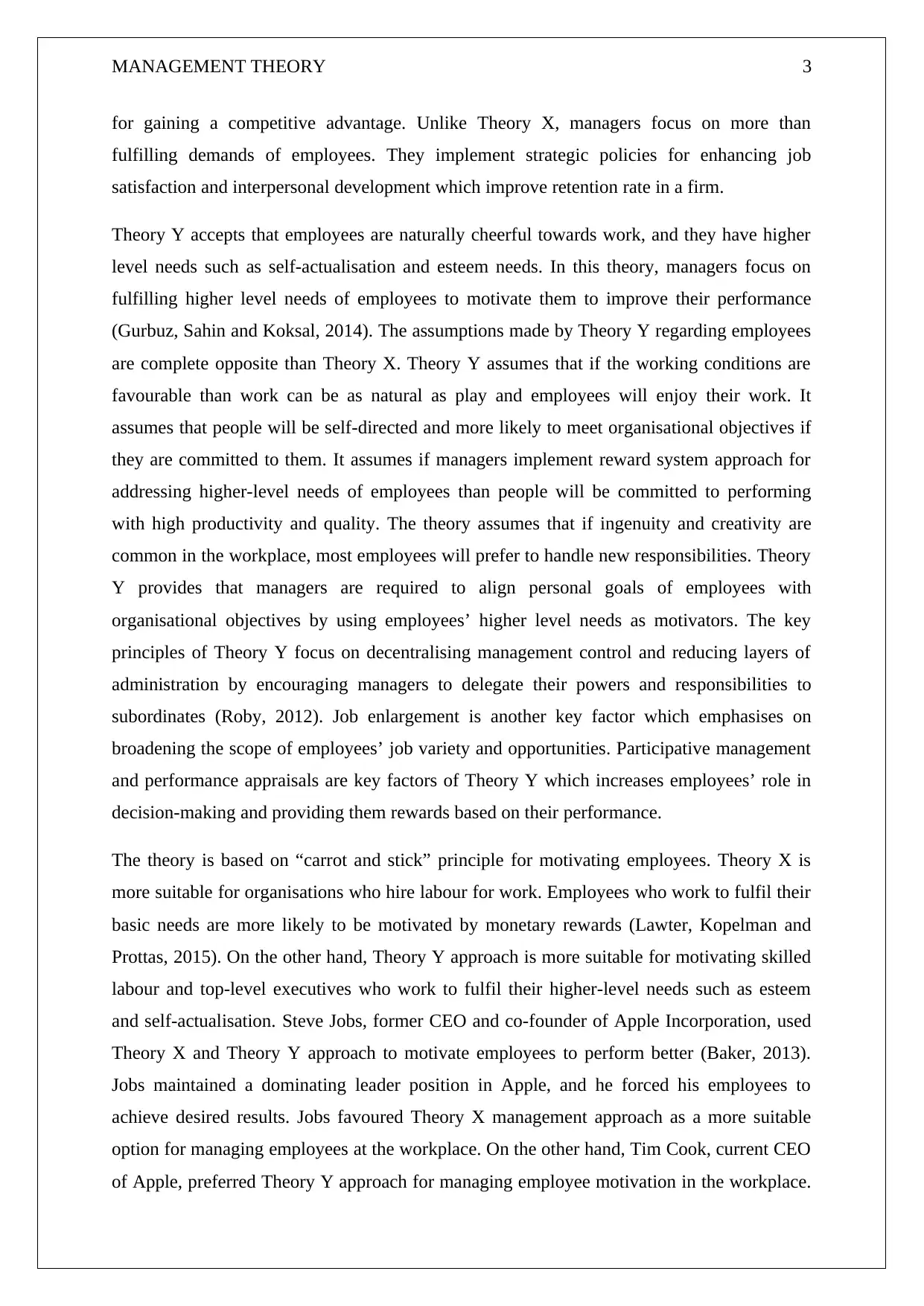
MANAGEMENT THEORY 3
for gaining a competitive advantage. Unlike Theory X, managers focus on more than
fulfilling demands of employees. They implement strategic policies for enhancing job
satisfaction and interpersonal development which improve retention rate in a firm.
Theory Y accepts that employees are naturally cheerful towards work, and they have higher
level needs such as self-actualisation and esteem needs. In this theory, managers focus on
fulfilling higher level needs of employees to motivate them to improve their performance
(Gurbuz, Sahin and Koksal, 2014). The assumptions made by Theory Y regarding employees
are complete opposite than Theory X. Theory Y assumes that if the working conditions are
favourable than work can be as natural as play and employees will enjoy their work. It
assumes that people will be self-directed and more likely to meet organisational objectives if
they are committed to them. It assumes if managers implement reward system approach for
addressing higher-level needs of employees than people will be committed to performing
with high productivity and quality. The theory assumes that if ingenuity and creativity are
common in the workplace, most employees will prefer to handle new responsibilities. Theory
Y provides that managers are required to align personal goals of employees with
organisational objectives by using employees’ higher level needs as motivators. The key
principles of Theory Y focus on decentralising management control and reducing layers of
administration by encouraging managers to delegate their powers and responsibilities to
subordinates (Roby, 2012). Job enlargement is another key factor which emphasises on
broadening the scope of employees’ job variety and opportunities. Participative management
and performance appraisals are key factors of Theory Y which increases employees’ role in
decision-making and providing them rewards based on their performance.
The theory is based on “carrot and stick” principle for motivating employees. Theory X is
more suitable for organisations who hire labour for work. Employees who work to fulfil their
basic needs are more likely to be motivated by monetary rewards (Lawter, Kopelman and
Prottas, 2015). On the other hand, Theory Y approach is more suitable for motivating skilled
labour and top-level executives who work to fulfil their higher-level needs such as esteem
and self-actualisation. Steve Jobs, former CEO and co-founder of Apple Incorporation, used
Theory X and Theory Y approach to motivate employees to perform better (Baker, 2013).
Jobs maintained a dominating leader position in Apple, and he forced his employees to
achieve desired results. Jobs favoured Theory X management approach as a more suitable
option for managing employees at the workplace. On the other hand, Tim Cook, current CEO
of Apple, preferred Theory Y approach for managing employee motivation in the workplace.
for gaining a competitive advantage. Unlike Theory X, managers focus on more than
fulfilling demands of employees. They implement strategic policies for enhancing job
satisfaction and interpersonal development which improve retention rate in a firm.
Theory Y accepts that employees are naturally cheerful towards work, and they have higher
level needs such as self-actualisation and esteem needs. In this theory, managers focus on
fulfilling higher level needs of employees to motivate them to improve their performance
(Gurbuz, Sahin and Koksal, 2014). The assumptions made by Theory Y regarding employees
are complete opposite than Theory X. Theory Y assumes that if the working conditions are
favourable than work can be as natural as play and employees will enjoy their work. It
assumes that people will be self-directed and more likely to meet organisational objectives if
they are committed to them. It assumes if managers implement reward system approach for
addressing higher-level needs of employees than people will be committed to performing
with high productivity and quality. The theory assumes that if ingenuity and creativity are
common in the workplace, most employees will prefer to handle new responsibilities. Theory
Y provides that managers are required to align personal goals of employees with
organisational objectives by using employees’ higher level needs as motivators. The key
principles of Theory Y focus on decentralising management control and reducing layers of
administration by encouraging managers to delegate their powers and responsibilities to
subordinates (Roby, 2012). Job enlargement is another key factor which emphasises on
broadening the scope of employees’ job variety and opportunities. Participative management
and performance appraisals are key factors of Theory Y which increases employees’ role in
decision-making and providing them rewards based on their performance.
The theory is based on “carrot and stick” principle for motivating employees. Theory X is
more suitable for organisations who hire labour for work. Employees who work to fulfil their
basic needs are more likely to be motivated by monetary rewards (Lawter, Kopelman and
Prottas, 2015). On the other hand, Theory Y approach is more suitable for motivating skilled
labour and top-level executives who work to fulfil their higher-level needs such as esteem
and self-actualisation. Steve Jobs, former CEO and co-founder of Apple Incorporation, used
Theory X and Theory Y approach to motivate employees to perform better (Baker, 2013).
Jobs maintained a dominating leader position in Apple, and he forced his employees to
achieve desired results. Jobs favoured Theory X management approach as a more suitable
option for managing employees at the workplace. On the other hand, Tim Cook, current CEO
of Apple, preferred Theory Y approach for managing employee motivation in the workplace.
Paraphrase This Document
Need a fresh take? Get an instant paraphrase of this document with our AI Paraphraser
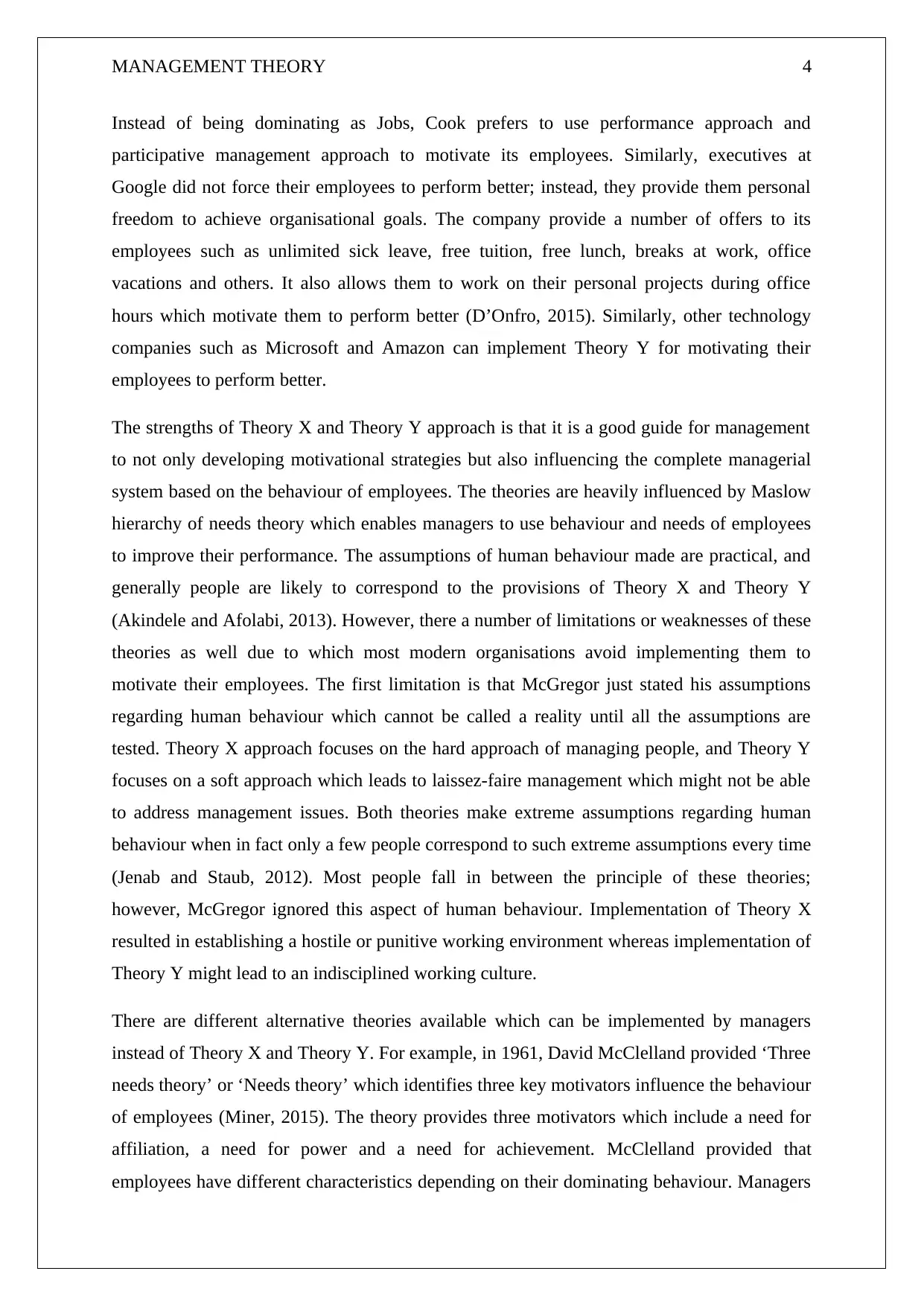
MANAGEMENT THEORY 4
Instead of being dominating as Jobs, Cook prefers to use performance approach and
participative management approach to motivate its employees. Similarly, executives at
Google did not force their employees to perform better; instead, they provide them personal
freedom to achieve organisational goals. The company provide a number of offers to its
employees such as unlimited sick leave, free tuition, free lunch, breaks at work, office
vacations and others. It also allows them to work on their personal projects during office
hours which motivate them to perform better (D’Onfro, 2015). Similarly, other technology
companies such as Microsoft and Amazon can implement Theory Y for motivating their
employees to perform better.
The strengths of Theory X and Theory Y approach is that it is a good guide for management
to not only developing motivational strategies but also influencing the complete managerial
system based on the behaviour of employees. The theories are heavily influenced by Maslow
hierarchy of needs theory which enables managers to use behaviour and needs of employees
to improve their performance. The assumptions of human behaviour made are practical, and
generally people are likely to correspond to the provisions of Theory X and Theory Y
(Akindele and Afolabi, 2013). However, there a number of limitations or weaknesses of these
theories as well due to which most modern organisations avoid implementing them to
motivate their employees. The first limitation is that McGregor just stated his assumptions
regarding human behaviour which cannot be called a reality until all the assumptions are
tested. Theory X approach focuses on the hard approach of managing people, and Theory Y
focuses on a soft approach which leads to laissez-faire management which might not be able
to address management issues. Both theories make extreme assumptions regarding human
behaviour when in fact only a few people correspond to such extreme assumptions every time
(Jenab and Staub, 2012). Most people fall in between the principle of these theories;
however, McGregor ignored this aspect of human behaviour. Implementation of Theory X
resulted in establishing a hostile or punitive working environment whereas implementation of
Theory Y might lead to an indisciplined working culture.
There are different alternative theories available which can be implemented by managers
instead of Theory X and Theory Y. For example, in 1961, David McClelland provided ‘Three
needs theory’ or ‘Needs theory’ which identifies three key motivators influence the behaviour
of employees (Miner, 2015). The theory provides three motivators which include a need for
affiliation, a need for power and a need for achievement. McClelland provided that
employees have different characteristics depending on their dominating behaviour. Managers
Instead of being dominating as Jobs, Cook prefers to use performance approach and
participative management approach to motivate its employees. Similarly, executives at
Google did not force their employees to perform better; instead, they provide them personal
freedom to achieve organisational goals. The company provide a number of offers to its
employees such as unlimited sick leave, free tuition, free lunch, breaks at work, office
vacations and others. It also allows them to work on their personal projects during office
hours which motivate them to perform better (D’Onfro, 2015). Similarly, other technology
companies such as Microsoft and Amazon can implement Theory Y for motivating their
employees to perform better.
The strengths of Theory X and Theory Y approach is that it is a good guide for management
to not only developing motivational strategies but also influencing the complete managerial
system based on the behaviour of employees. The theories are heavily influenced by Maslow
hierarchy of needs theory which enables managers to use behaviour and needs of employees
to improve their performance. The assumptions of human behaviour made are practical, and
generally people are likely to correspond to the provisions of Theory X and Theory Y
(Akindele and Afolabi, 2013). However, there a number of limitations or weaknesses of these
theories as well due to which most modern organisations avoid implementing them to
motivate their employees. The first limitation is that McGregor just stated his assumptions
regarding human behaviour which cannot be called a reality until all the assumptions are
tested. Theory X approach focuses on the hard approach of managing people, and Theory Y
focuses on a soft approach which leads to laissez-faire management which might not be able
to address management issues. Both theories make extreme assumptions regarding human
behaviour when in fact only a few people correspond to such extreme assumptions every time
(Jenab and Staub, 2012). Most people fall in between the principle of these theories;
however, McGregor ignored this aspect of human behaviour. Implementation of Theory X
resulted in establishing a hostile or punitive working environment whereas implementation of
Theory Y might lead to an indisciplined working culture.
There are different alternative theories available which can be implemented by managers
instead of Theory X and Theory Y. For example, in 1961, David McClelland provided ‘Three
needs theory’ or ‘Needs theory’ which identifies three key motivators influence the behaviour
of employees (Miner, 2015). The theory provides three motivators which include a need for
affiliation, a need for power and a need for achievement. McClelland provided that
employees have different characteristics depending on their dominating behaviour. Managers
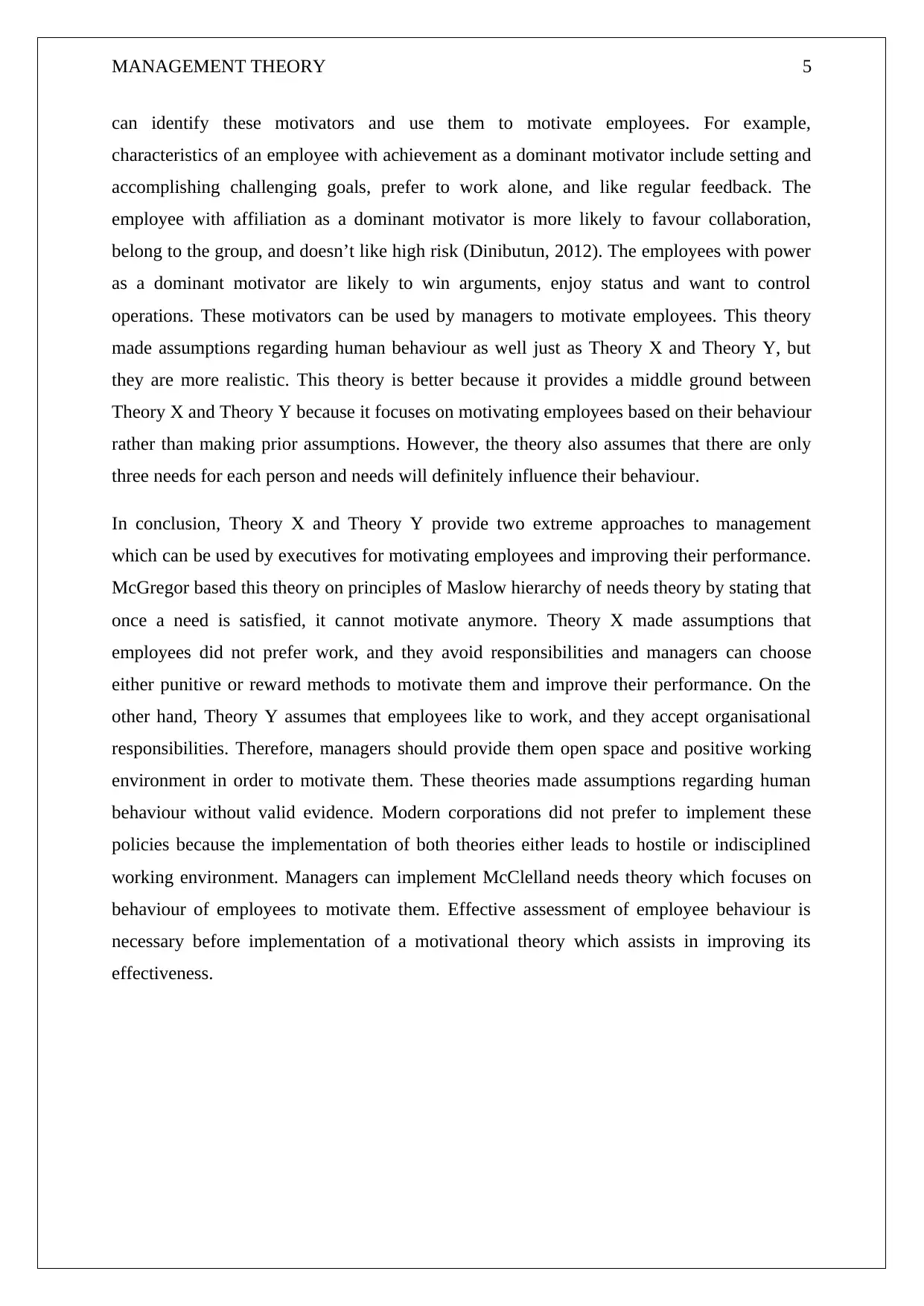
MANAGEMENT THEORY 5
can identify these motivators and use them to motivate employees. For example,
characteristics of an employee with achievement as a dominant motivator include setting and
accomplishing challenging goals, prefer to work alone, and like regular feedback. The
employee with affiliation as a dominant motivator is more likely to favour collaboration,
belong to the group, and doesn’t like high risk (Dinibutun, 2012). The employees with power
as a dominant motivator are likely to win arguments, enjoy status and want to control
operations. These motivators can be used by managers to motivate employees. This theory
made assumptions regarding human behaviour as well just as Theory X and Theory Y, but
they are more realistic. This theory is better because it provides a middle ground between
Theory X and Theory Y because it focuses on motivating employees based on their behaviour
rather than making prior assumptions. However, the theory also assumes that there are only
three needs for each person and needs will definitely influence their behaviour.
In conclusion, Theory X and Theory Y provide two extreme approaches to management
which can be used by executives for motivating employees and improving their performance.
McGregor based this theory on principles of Maslow hierarchy of needs theory by stating that
once a need is satisfied, it cannot motivate anymore. Theory X made assumptions that
employees did not prefer work, and they avoid responsibilities and managers can choose
either punitive or reward methods to motivate them and improve their performance. On the
other hand, Theory Y assumes that employees like to work, and they accept organisational
responsibilities. Therefore, managers should provide them open space and positive working
environment in order to motivate them. These theories made assumptions regarding human
behaviour without valid evidence. Modern corporations did not prefer to implement these
policies because the implementation of both theories either leads to hostile or indisciplined
working environment. Managers can implement McClelland needs theory which focuses on
behaviour of employees to motivate them. Effective assessment of employee behaviour is
necessary before implementation of a motivational theory which assists in improving its
effectiveness.
can identify these motivators and use them to motivate employees. For example,
characteristics of an employee with achievement as a dominant motivator include setting and
accomplishing challenging goals, prefer to work alone, and like regular feedback. The
employee with affiliation as a dominant motivator is more likely to favour collaboration,
belong to the group, and doesn’t like high risk (Dinibutun, 2012). The employees with power
as a dominant motivator are likely to win arguments, enjoy status and want to control
operations. These motivators can be used by managers to motivate employees. This theory
made assumptions regarding human behaviour as well just as Theory X and Theory Y, but
they are more realistic. This theory is better because it provides a middle ground between
Theory X and Theory Y because it focuses on motivating employees based on their behaviour
rather than making prior assumptions. However, the theory also assumes that there are only
three needs for each person and needs will definitely influence their behaviour.
In conclusion, Theory X and Theory Y provide two extreme approaches to management
which can be used by executives for motivating employees and improving their performance.
McGregor based this theory on principles of Maslow hierarchy of needs theory by stating that
once a need is satisfied, it cannot motivate anymore. Theory X made assumptions that
employees did not prefer work, and they avoid responsibilities and managers can choose
either punitive or reward methods to motivate them and improve their performance. On the
other hand, Theory Y assumes that employees like to work, and they accept organisational
responsibilities. Therefore, managers should provide them open space and positive working
environment in order to motivate them. These theories made assumptions regarding human
behaviour without valid evidence. Modern corporations did not prefer to implement these
policies because the implementation of both theories either leads to hostile or indisciplined
working environment. Managers can implement McClelland needs theory which focuses on
behaviour of employees to motivate them. Effective assessment of employee behaviour is
necessary before implementation of a motivational theory which assists in improving its
effectiveness.
⊘ This is a preview!⊘
Do you want full access?
Subscribe today to unlock all pages.

Trusted by 1+ million students worldwide
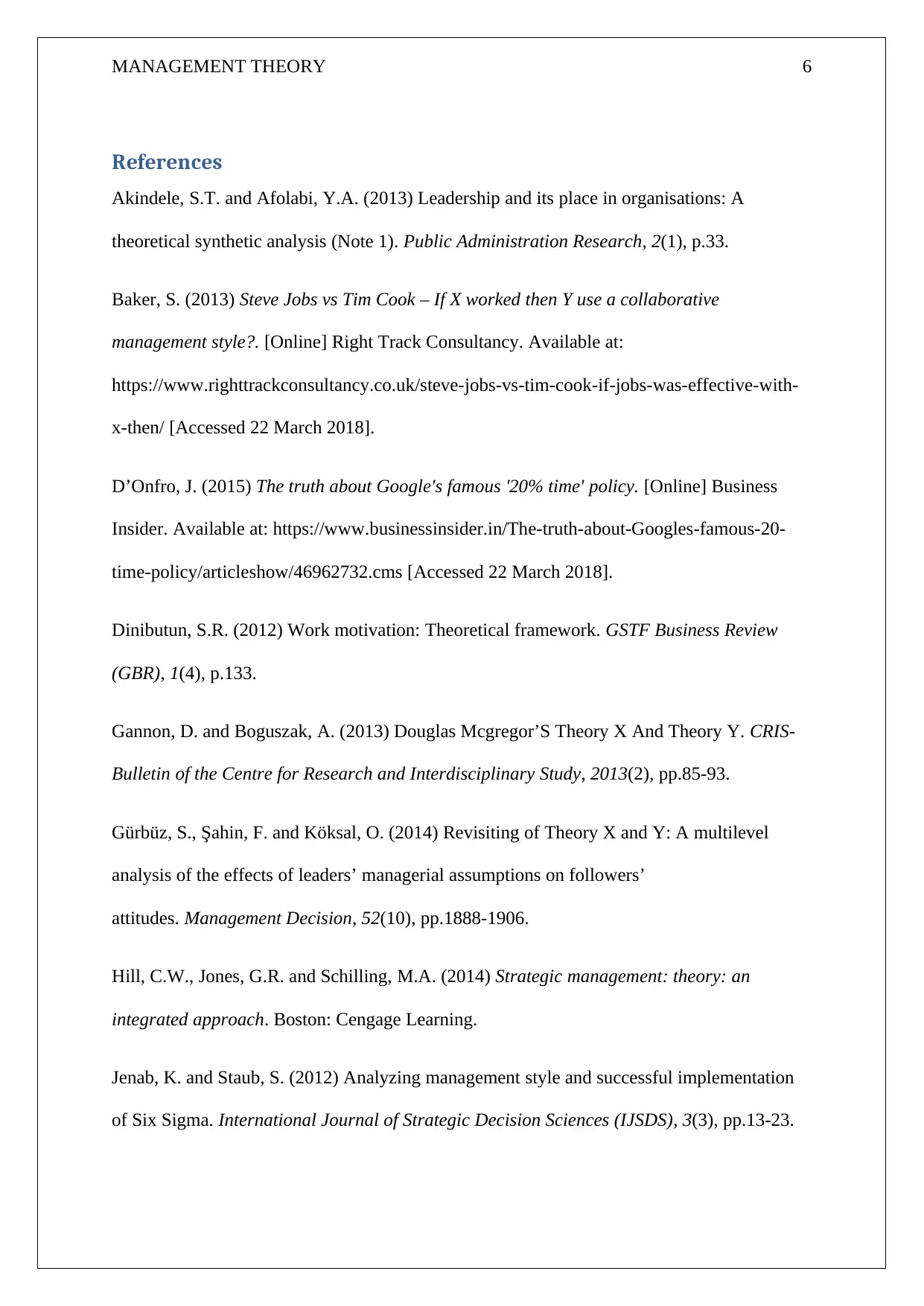
MANAGEMENT THEORY 6
References
Akindele, S.T. and Afolabi, Y.A. (2013) Leadership and its place in organisations: A
theoretical synthetic analysis (Note 1). Public Administration Research, 2(1), p.33.
Baker, S. (2013) Steve Jobs vs Tim Cook – If X worked then Y use a collaborative
management style?. [Online] Right Track Consultancy. Available at:
https://www.righttrackconsultancy.co.uk/steve-jobs-vs-tim-cook-if-jobs-was-effective-with-
x-then/ [Accessed 22 March 2018].
D’Onfro, J. (2015) The truth about Google's famous '20% time' policy. [Online] Business
Insider. Available at: https://www.businessinsider.in/The-truth-about-Googles-famous-20-
time-policy/articleshow/46962732.cms [Accessed 22 March 2018].
Dinibutun, S.R. (2012) Work motivation: Theoretical framework. GSTF Business Review
(GBR), 1(4), p.133.
Gannon, D. and Boguszak, A. (2013) Douglas Mcgregor’S Theory X And Theory Y. CRIS-
Bulletin of the Centre for Research and Interdisciplinary Study, 2013(2), pp.85-93.
Gürbüz, S., Şahin, F. and Köksal, O. (2014) Revisiting of Theory X and Y: A multilevel
analysis of the effects of leaders’ managerial assumptions on followers’
attitudes. Management Decision, 52(10), pp.1888-1906.
Hill, C.W., Jones, G.R. and Schilling, M.A. (2014) Strategic management: theory: an
integrated approach. Boston: Cengage Learning.
Jenab, K. and Staub, S. (2012) Analyzing management style and successful implementation
of Six Sigma. International Journal of Strategic Decision Sciences (IJSDS), 3(3), pp.13-23.
References
Akindele, S.T. and Afolabi, Y.A. (2013) Leadership and its place in organisations: A
theoretical synthetic analysis (Note 1). Public Administration Research, 2(1), p.33.
Baker, S. (2013) Steve Jobs vs Tim Cook – If X worked then Y use a collaborative
management style?. [Online] Right Track Consultancy. Available at:
https://www.righttrackconsultancy.co.uk/steve-jobs-vs-tim-cook-if-jobs-was-effective-with-
x-then/ [Accessed 22 March 2018].
D’Onfro, J. (2015) The truth about Google's famous '20% time' policy. [Online] Business
Insider. Available at: https://www.businessinsider.in/The-truth-about-Googles-famous-20-
time-policy/articleshow/46962732.cms [Accessed 22 March 2018].
Dinibutun, S.R. (2012) Work motivation: Theoretical framework. GSTF Business Review
(GBR), 1(4), p.133.
Gannon, D. and Boguszak, A. (2013) Douglas Mcgregor’S Theory X And Theory Y. CRIS-
Bulletin of the Centre for Research and Interdisciplinary Study, 2013(2), pp.85-93.
Gürbüz, S., Şahin, F. and Köksal, O. (2014) Revisiting of Theory X and Y: A multilevel
analysis of the effects of leaders’ managerial assumptions on followers’
attitudes. Management Decision, 52(10), pp.1888-1906.
Hill, C.W., Jones, G.R. and Schilling, M.A. (2014) Strategic management: theory: an
integrated approach. Boston: Cengage Learning.
Jenab, K. and Staub, S. (2012) Analyzing management style and successful implementation
of Six Sigma. International Journal of Strategic Decision Sciences (IJSDS), 3(3), pp.13-23.
Paraphrase This Document
Need a fresh take? Get an instant paraphrase of this document with our AI Paraphraser
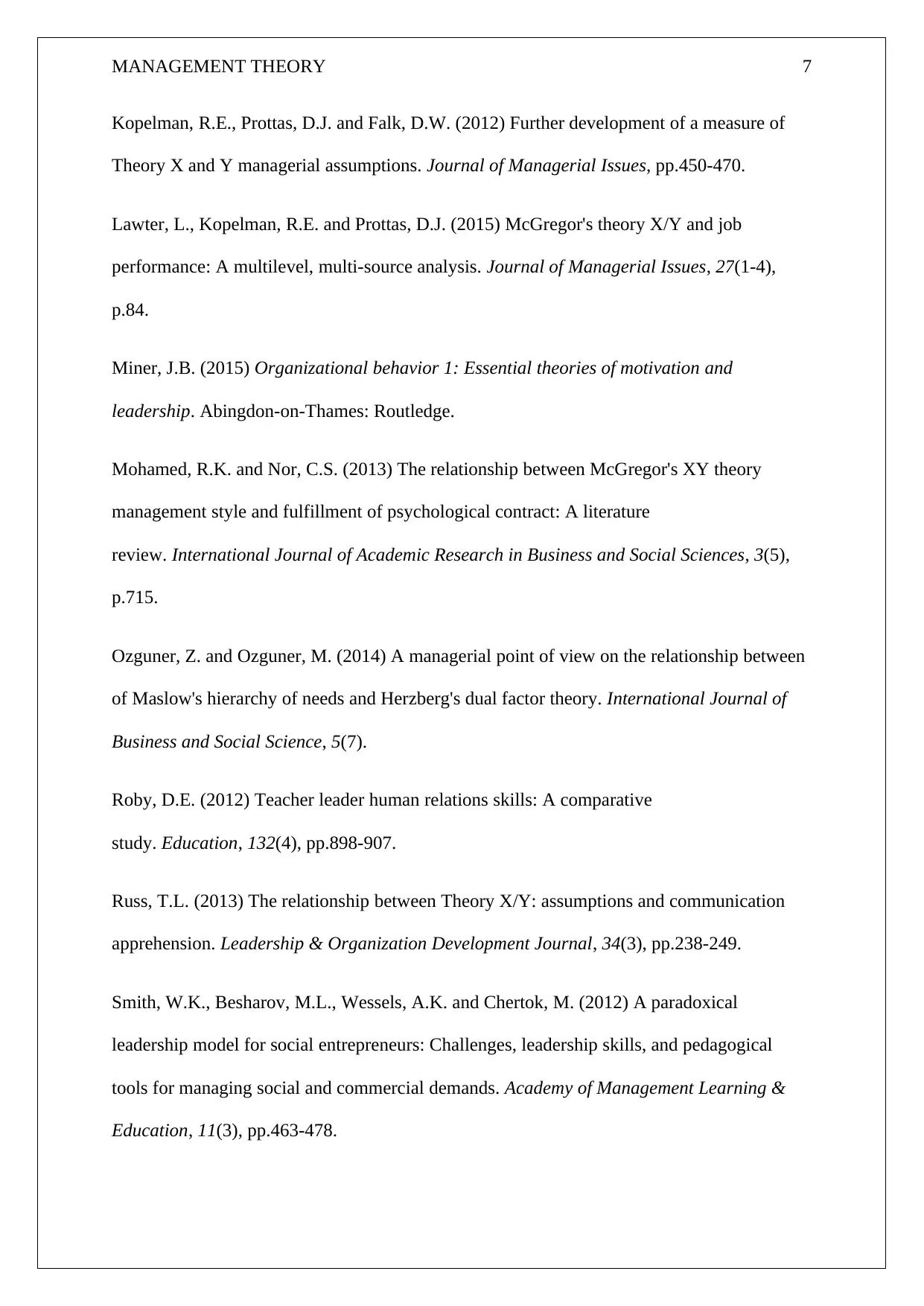
MANAGEMENT THEORY 7
Kopelman, R.E., Prottas, D.J. and Falk, D.W. (2012) Further development of a measure of
Theory X and Y managerial assumptions. Journal of Managerial Issues, pp.450-470.
Lawter, L., Kopelman, R.E. and Prottas, D.J. (2015) McGregor's theory X/Y and job
performance: A multilevel, multi-source analysis. Journal of Managerial Issues, 27(1-4),
p.84.
Miner, J.B. (2015) Organizational behavior 1: Essential theories of motivation and
leadership. Abingdon-on-Thames: Routledge.
Mohamed, R.K. and Nor, C.S. (2013) The relationship between McGregor's XY theory
management style and fulfillment of psychological contract: A literature
review. International Journal of Academic Research in Business and Social Sciences, 3(5),
p.715.
Ozguner, Z. and Ozguner, M. (2014) A managerial point of view on the relationship between
of Maslow's hierarchy of needs and Herzberg's dual factor theory. International Journal of
Business and Social Science, 5(7).
Roby, D.E. (2012) Teacher leader human relations skills: A comparative
study. Education, 132(4), pp.898-907.
Russ, T.L. (2013) The relationship between Theory X/Y: assumptions and communication
apprehension. Leadership & Organization Development Journal, 34(3), pp.238-249.
Smith, W.K., Besharov, M.L., Wessels, A.K. and Chertok, M. (2012) A paradoxical
leadership model for social entrepreneurs: Challenges, leadership skills, and pedagogical
tools for managing social and commercial demands. Academy of Management Learning &
Education, 11(3), pp.463-478.
Kopelman, R.E., Prottas, D.J. and Falk, D.W. (2012) Further development of a measure of
Theory X and Y managerial assumptions. Journal of Managerial Issues, pp.450-470.
Lawter, L., Kopelman, R.E. and Prottas, D.J. (2015) McGregor's theory X/Y and job
performance: A multilevel, multi-source analysis. Journal of Managerial Issues, 27(1-4),
p.84.
Miner, J.B. (2015) Organizational behavior 1: Essential theories of motivation and
leadership. Abingdon-on-Thames: Routledge.
Mohamed, R.K. and Nor, C.S. (2013) The relationship between McGregor's XY theory
management style and fulfillment of psychological contract: A literature
review. International Journal of Academic Research in Business and Social Sciences, 3(5),
p.715.
Ozguner, Z. and Ozguner, M. (2014) A managerial point of view on the relationship between
of Maslow's hierarchy of needs and Herzberg's dual factor theory. International Journal of
Business and Social Science, 5(7).
Roby, D.E. (2012) Teacher leader human relations skills: A comparative
study. Education, 132(4), pp.898-907.
Russ, T.L. (2013) The relationship between Theory X/Y: assumptions and communication
apprehension. Leadership & Organization Development Journal, 34(3), pp.238-249.
Smith, W.K., Besharov, M.L., Wessels, A.K. and Chertok, M. (2012) A paradoxical
leadership model for social entrepreneurs: Challenges, leadership skills, and pedagogical
tools for managing social and commercial demands. Academy of Management Learning &
Education, 11(3), pp.463-478.
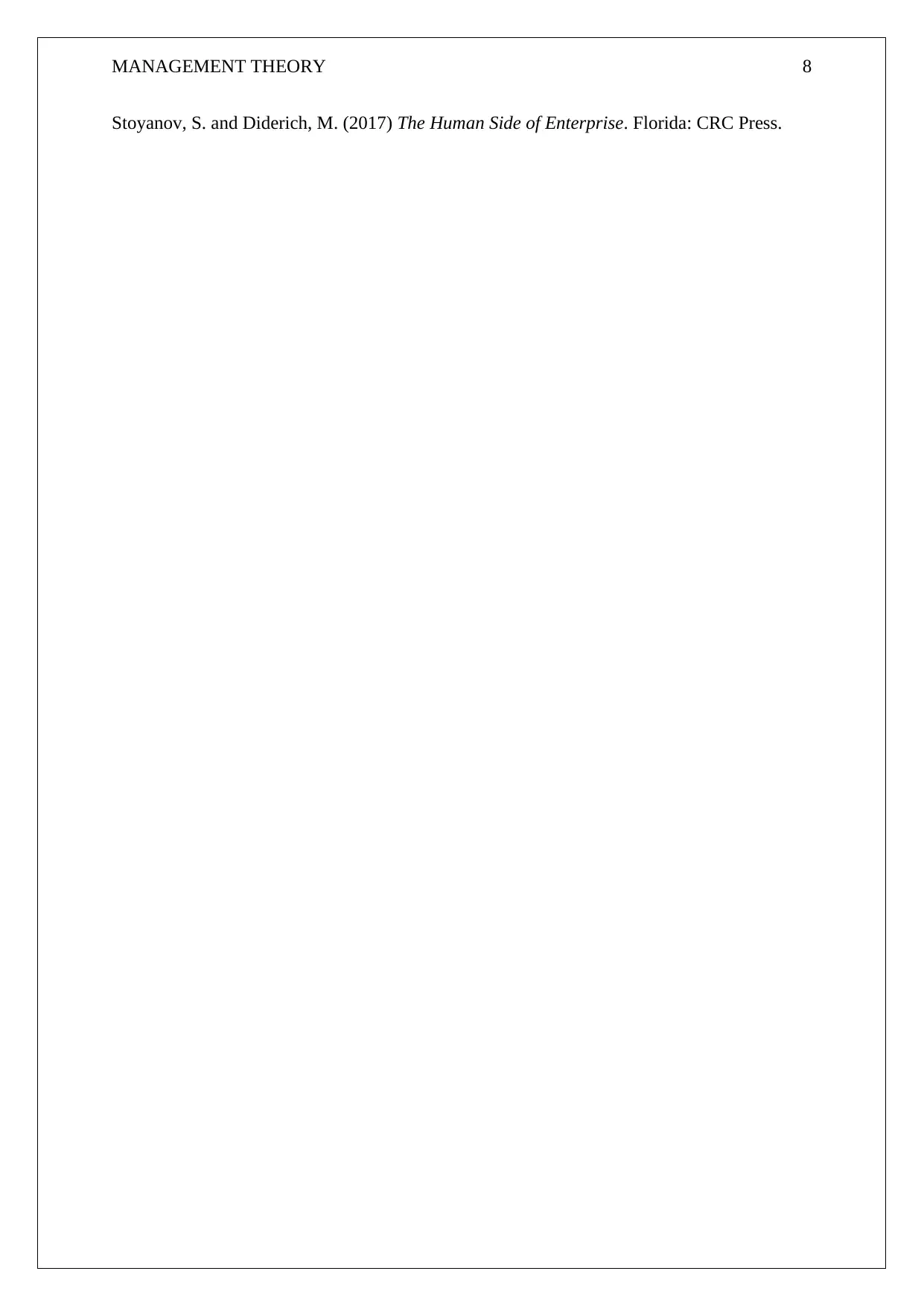
MANAGEMENT THEORY 8
Stoyanov, S. and Diderich, M. (2017) The Human Side of Enterprise. Florida: CRC Press.
Stoyanov, S. and Diderich, M. (2017) The Human Side of Enterprise. Florida: CRC Press.
⊘ This is a preview!⊘
Do you want full access?
Subscribe today to unlock all pages.

Trusted by 1+ million students worldwide
1 out of 9
Related Documents
Your All-in-One AI-Powered Toolkit for Academic Success.
+13062052269
info@desklib.com
Available 24*7 on WhatsApp / Email
![[object Object]](/_next/static/media/star-bottom.7253800d.svg)
Unlock your academic potential
Copyright © 2020–2025 A2Z Services. All Rights Reserved. Developed and managed by ZUCOL.





